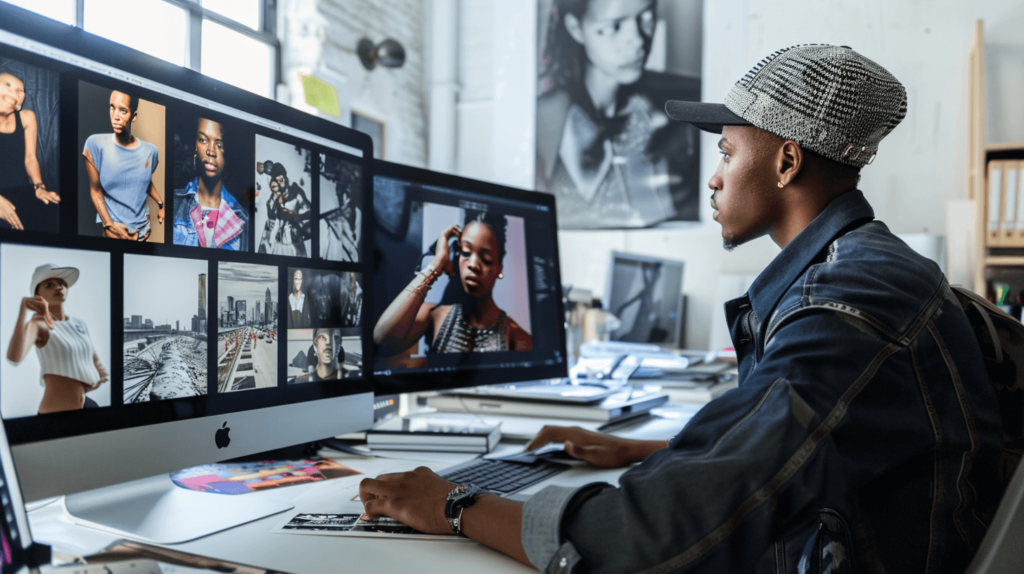Introduction

A well-crafted job description is more than just a list of duties and requirements—it is a pivotal tool in the hiring process and a fundamental step in career development. For employers, the clarity and thoroughness of a job description can determine the quality of applicants it attracts, ensuring that only candidates who are genuinely fit for the role consider applying. For job seekers, a detailed job description provides crucial insights into what a potential employer values most, helping them to align their application to meet those expectations precisely.
If your goal is to secure the best job description template available—a foundational tool for crafting your own hiring specifications—look no further. Click the link below to download our complimentary Photo Editor Job Description template. This document embodies the core principles and best practices of C9Staff’s renowned hiring methodology, providing you with a robust framework to attract and identify the most qualified candidates effectively. Enhance your recruitment process with our expertly designed template today.
Photo Editor Job Description Template

This guide is designed with a dual perspective to serve both parties effectively. For employers, it offers detailed steps to construct precise and culturally aligned job descriptions that resonate with the ideal candidates. For job seekers, it provides a deeper understanding of job listings, helping them decipher the often-complex language of job requirements and how to match their skills and experiences with what is being asked.
As we explore into the subsequent sections, we will explore what it truly means to be a photo editor, the skills and qualifications that are most sought after, and how both job seekers and employers can navigate the intricacies of job descriptions in the field of photo editing. Whether you are drafting a job description to attract top talent or tailoring your resume to land your dream job, this guide will equip you with comprehensive insights to approach these tasks strategically.
Stay with us as we unpack the essentials of becoming and hiring a photo editor, providing you with all the tools you need to succeed in this dynamic field.
What is a Photo Editor?

A photo editor is not just a person behind a computer tweaking image. This role is a pivotal element in the visual storytelling that shapes our perception of the world through media. In various industries, from advertising and journalism to fashion and entertainment, photo editors are responsible for the selection, editing, and positioning of photographs that align with a publication’s vision, narrative, and aesthetic standards.
Key Responsibilities of a Photo Editor
The responsibilities of a photo editor extend beyond mere photo adjustments. Technically, they might work with advanced editing software to enhance image quality, correct colors, or manipulate compositions. Creatively, they are tasked with conceptualizing visual narratives that resonate with viewers, selecting images that tell a story or evoke the right emotions. Administratively, they often manage photography assets, coordinate with photographers and other creatives, and ensure timely delivery of visual content. For instance, in a major fashion magazine, a photo editor’s decision on which photos to feature can influence fashion trends and brand success worldwide.
Historical Evolution of the Role
The role of a photo editor originated in print media, where editors had the crucial job of picking the right photograph to go alongside news stories and features. With the digital revolution, the scope of this role expanded tremendously. The introduction of software like Adobe Photoshop in the late 1980s marked a significant milestone, offering photo editors unprecedented control over image manipulation and creativity. This shift not only transformed the workflow from analog to digital but also expanded the photo editor’s influence in the production of digital content.
Significance in Today’s Digital Age
Today, as digital platforms dominate media consumption, the role of photo editors has become more crucial than ever. They play a key role in shaping how brands and stories are perceived by the public. In an era where images can go viral in seconds, photo editors are vital in managing the visual impact of those images. Their work influences everything from consumer behavior in e-commerce to viewer engagement in digital news.
As you continue reading, consider how the tools and platforms at a photo editor’s disposal are continually evolving, pushing the boundaries of what can be achieved in visual content. This ongoing evolution not only impacts their current responsibilities but also points to future trends in the field, which we will explore in the coming sections.
Core Responsibilities of a Photo Editor

In the world of media and publishing, the photo editor stands as a pivotal figure whose daily responsibilities shape the visual direction of content. Let’s dive into these duties to understand what truly makes a photo editor essential in any creative setting.
Typical Job Duties of a Photo Editor:
Image Selection: Sifting through hundreds, sometimes thousands, of images to find the perfect shot that aligns with the story’s mood, style, and message.
Photo Enhancement: Adjusting color balance, sharpening details, and correcting exposures to bring out the best in each photograph.
Layout Design: Collaborating with graphic designers to strategically place images in layouts, ensuring that each photo complements the textual content and overall design schema.
Photographer Collaboration: Working closely with photographers from the planning phase to execution, providing guidelines about the theme and specific needs of projects.
Rights Management: Ensuring all images have the appropriate licenses and copyrights cleared for use, preventing legal issues related to image use.
Team Coordination: Leading a team of assistants, interns, or junior editors, delegating tasks, and ensuring deadlines are met without compromising quality.
Real-World Examples of Daily Tasks:
Imagine a photo editor working on a major marketing campaign. The day begins with a briefing session where the marketing team outlines the campaign’s goals. The editor then reviews a pre-selected pool of images, choosing those that best fit the campaign’s theme. Each image is meticulously enhanced and formatted to fit various digital platforms, from social media ads to large-scale prints. Collaboration is key, as the editor frequently consults with graphic designers and the digital strategy team to ensure each image is optimized for its intended audience.
Essential Skills and Qualifications

At the core of a photo editor’s toolbox are technical skills that involve mastery over software like Adobe Photoshop, Lightroom, and other graphic design tools. These skills are essential for tasks such as photo retouching, color correction, and layout design. For example, proficiency in Photoshop allows editors to manipulate images to fit the narrative of a piece, adjusting everything from hues to saturation, ensuring that the visual elements perfectly complement the textual content. This technical acumen is critical, not only for enhancing aesthetics but also for ensuring that images meet the technical requirements for various publishing platforms.
Soft Skills
However, the capabilities of a photo editor extend beyond software proficiency. Soft skills like communication, creativity, and attention to detail are equally vital. Effective communication enables photo editors to clearly articulate vision and feedback, ensuring alignment with photographers and graphic designers. Creativity is what allows photo editors to see beyond the obvious, envisioning images that capture imaginations and convey deeper stories. Attention to detail ensures that every pixel serves a purpose, maintaining high quality and consistency across all visual outputs.
For instance, consider a photo editor working on a tight deadline for a high-profile advertising campaign. This scenario requires not only rapid adjustments to images but also constant coordination with the marketing team and designers, ensuring that every visual element aligns with the campaign’s strategic goals.
Educational and Professional Background
Most successful photo editors hold degrees in fields such as photography, graphic design, or digital media. Certifications in specific editing software can also bolster a candidate’s qualifications. Professional experience, particularly in roles that blend creativity with technical skills, is highly valued. Internships or previous positions in media, advertising, or publishing provide practical experience that is crucial for understanding the full scope of a photo editor’s responsibilities.
Sidebar: Quick Tips on How to Demonstrate These Skills in a Resume or Portfolio
Showcase Specific Projects: Include a portfolio of before and after editing examples to demonstrate your proficiency and creativity.
Describe Problem-solving Scenarios: Outline situations where your intervention as a photo editor changed the outcome of a project.
List Relevant Courses or Certifications: Highlight any specialized training or certification in popular photo editing software or creative design courses.
Master 90% of Photo Editing Basics in Just 15 Minutes!
Crafting the Perfect Photo Editor Job Description (Employers)

This section provides a comprehensive and actionable guide for employers on how to craft an effective job description for a photo editor. The structured approach not only lays out the crucial elements of the job description but also emphasizes the alignment with company culture and strategic objectives, ensuring that the job description attracts the right candidates.
Key Highlights of the Section:
Introduction: Sets the importance of clear and precise job descriptions in attracting qualified candidates and communicating company expectations.
Step-by-Step Guide:
Job Title and Summary: Advises on starting with a descriptive title and a clear summary to set the correct expectations and attract the right applicants.
Detailed Responsibilities: Suggests listing specific tasks to give potential candidates a clear idea of their daily roles and how these contribute to the company’s goals.
Required Skills and Qualifications: Emphasizes the need for specifying both technical and soft skills, ensuring candidates understand the qualifications and traits they need to succeed in the role.
Alignment with Company Culture: Highlights the importance of reflecting the company’s values and mission in the job description to attract candidates who are not only capable but also a cultural fit.
Infographic on Writing Dos and Don’ts: Offers a visual tool to help employers avoid common pitfalls in job description writing, promoting best practices like inclusivity and clarity.
If your goal is to secure the best job description template available—a foundational tool for crafting your own hiring specifications—look no further. Click the link below to download our complimentary Photo Editor Job Description template. This document embodies the core principles and best practices of C9Staff’s renowned hiring methodology, providing you with a robust framework to attract and identify the most qualified candidates effectively. Enhance your recruitment process with our expertly designed template today.
Photo Editor Job Description Template

How to Read and Respond to a Photo Editor Job Description (Job Seekers)

When searching for a photo editor position, the first step is to thoroughly read and understand the job description. Each description provides crucial insights into what an employer values, detailing not only the skills and experiences required but also giving hints about the company culture and priorities. Approach each listing as a roadmap that guides how you should tailor your application to align with the employer’s expectations.
Interpreting Job Listings
Start by identifying key skills and qualifications mentioned in the job description. Notice the language used—terms like “detail-oriented,” “creative vision,” and “collaborative team player” are not just buzzwords but insights into the company’s culture and the attributes they value in employees. Understand these cues to assess whether your skills and career aspirations fit with the potential employer’s vision.
Tailoring Your Application
To make your application stand out, mirror the language of the job description in your resume and cover letter. Highlight your experiences that directly respond to the listed responsibilities and requirements. For instance, if the job description emphasizes creativity and innovation, showcase projects where you have demonstrated these qualities.
Showcasing Skills and Experiences
Organize your portfolio to lead with projects that are most relevant to the job description. Describe each project in a way that ties back to the specifics of the role, focusing on how your contributions made a measurable impact. This strategy not only showcases your technical skills but also demonstrates your understanding of how those skills apply in a professional setting.
Ready to supercharge your career and land your dream job? Submit your resume to C9Staff’s talent acquisition department today. Click the link below to get started. If your qualifications align with our client requirements, we’ll reach out to discuss potential opportunities tailored to your expertise and ambitions. Don’t miss the chance to connect with some of the top employers in your field and take the next big step in your professional journey.

Salary Expectations and Career Prospects

The earnings of photo editors can vary widely, influenced by factors such as geography, experience level, and the specific industry in which they work. For instance, photo editors in major urban centers often command higher salaries due to the higher cost of living and the concentration of jobs in industries like advertising and fashion. Entry-level photo editors might start with a salary ranging from $35,000 to $45,000 annually, while mid-career professionals could see their earnings grow to between $50,000 and $70,000. Seasoned professionals, especially those in senior roles or working in lucrative sectors, can expect salaries that exceed $100,000.
Career Trajectory and Growth Opportunities
The career path for photo editors is as dynamic as it is rewarding. Starting as junior photo editors, individuals can ascend to roles such as Senior Photo Editor, Photo Manager, or even Creative Director, depending on their skills, experiences, and the opportunities they seize. Essential for advancement are a keen eye for detail, a strong sense of creativity, and the ability to lead projects and teams effectively. Photo editors face challenges such as staying abreast of technological advancements and adapting to changing media landscapes, but these are also opportunities to stand out and excel.
Interview with a Professional Photo Editor on Career Growth
In an insightful discussion, Alex Morgan, a seasoned photo editor with over 15 years in the industry, shares his journey from an intern at a small magazine to becoming the Photo Director at a major fashion publication. Alex highlights the importance of continuous learning and adaptability in his career progress and offers advice for newcomers: “Always be ready to adapt to new technologies and keep your creative juices flowing by seeking inspiration everywhere.”
The Future of Photo Editing Jobs

The role of photo editors is being rapidly reshaped by advancements in artificial intelligence (AI), automation, and the shift towards remote work. AI and automation are streamlining complex tasks like color correction and object removal, freeing up photo editors to focus on more creative and strategic aspects of their work. This shift is not just about efficiency; it’s about enhancing the creative quality of visual content across industries.
As remote work becomes more common, photo editors are finding that digital collaboration tools are as important as their editing software. The ability to coordinate with remote teams effectively and ensure consistency in visual output across different media formats is becoming a new staple in the job description of the modern photo editor.
Skills for the Future
To remain relevant in this transforming landscape, photo editors will need to continuously adapt and refine their skill sets. Mastery of AI-enhanced tools is becoming essential, as these technologies integrate more deeply into standard workflows. However, technical prowess alone isn’t enough. Soft skills such as effective communication, strategic thinking, and adaptability are becoming critical, especially as team dynamics and project management move increasingly online.
Insights from Industry Leaders
Leading figures in digital media stress the importance of adaptability and foresight. Jane Doe, Chief Editor at Creatives Online, notes, “The future of photo editing is dynamic and incredibly exciting. Embracing AI tools can amplify our creative capabilities and lead to previously unimaginable quality and efficiency in photo editing.”
Another expert, John Smith, a pioneer in AI-based design, suggests, “The photo editors who will thrive are those who see technology as a partner in the creative process, not a replacement. It’s about leveraging these new tools to push the boundaries of what’s possible.”
Discover how C9Staff can streamline your hiring process for the ideal Photo Editor. Click the link below to schedule a free exploratory call with one of our account managers today. During this call, we will listen attentively to your specific needs and provide endorsements for potential candidates at no cost, helping you assess the best talent available at competitive prices. Let us help you find the perfect fit for your organization with precision and ease.

Conclusion

Throughout this guide, we’ve explored the multifaceted role of photo editors and the critical importance of precise and comprehensive job descriptions in shaping their careers and the operations of businesses. A well-structured job description does more than list duties—it acts as a bridge connecting the right candidates to the right roles, ensuring that both employers and job seekers have clear expectations and understand the qualifications required for success.
Employers and job seekers alike should view these job descriptions not just as necessary formalities but as foundational tools for career and business development. For employers, the precision in a job description can dramatically enhance the quality of applicant pools and ensure that the selected candidate is the best fit for the role and the company culture. For job seekers, a detailed job description provides crucial insights into whether a role aligns with their skills and career aspirations, allowing them to tailor their applications effectively and advance their professional growth.
As we look to the future of photo editing jobs, shaped by advancements in technology and changes in the work environment, the importance of adapting and refining job descriptions remains constant. Whether you are drafting or responding to a job description, remember that it is a dynamic tool designed to adapt to evolving roles and market conditions.
Do not stop here. Continue to engage with resources that can deepen your understanding and improve your practices around job descriptions. Explore interactive tools that simplify the creation and analysis of job descriptions, consult with professionals to refine your approach, or access further reading materials to stay ahead in the industry. Consider subscribing to our newsletter or following us on social media to receive ongoing tips and updates on career management and photo editing trends. Let this guide be a stepping stone to greater achievements in your professional journey.




